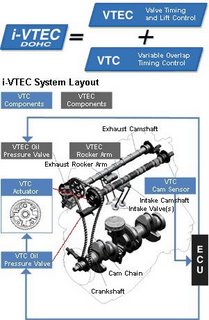Fuel Economy, Ample Torque, Clean Emissions
- The i-VTEC provides it all depending on engine load -
The DOHC i-VTEC utilizes smart valve control technology
The i-VTEC system utilizes Honda's proprietary VTEC sytem and adds VTC (Variable Timing Control), which allows for dynamic/continuous intake valve timing and overlap control.
The demanding aspects of fuel economy, ample torque, and clean emissions can all be controlled and provided at a higher level with VTEC (intake valve timing and lift control) and VTC (valve overlap control) combined.
The VTC actuator, installed on the intake camshaft, is controlled by oil pressure, to allow for dynamic and continuous valve timing to fit the load of the engine.
Additionally, the intake manifold length can be adjusted.
Combined with the DOHC i-VTEC, in order to obtain both ample low/mid-end torque and high-end output, a rotary valve is used inside the dual-passage intake manifold.
During low/mid rpm,, the rotary valve is closed, while it opens during high rpm's. By varying the intake path length according to engine rpm, ample torque is gained at all rpm levels. Additionally, the rotary valve design is superior over past butterfly valve (flap) in that it reduces intake resistance.




0 comments:
Post a Comment